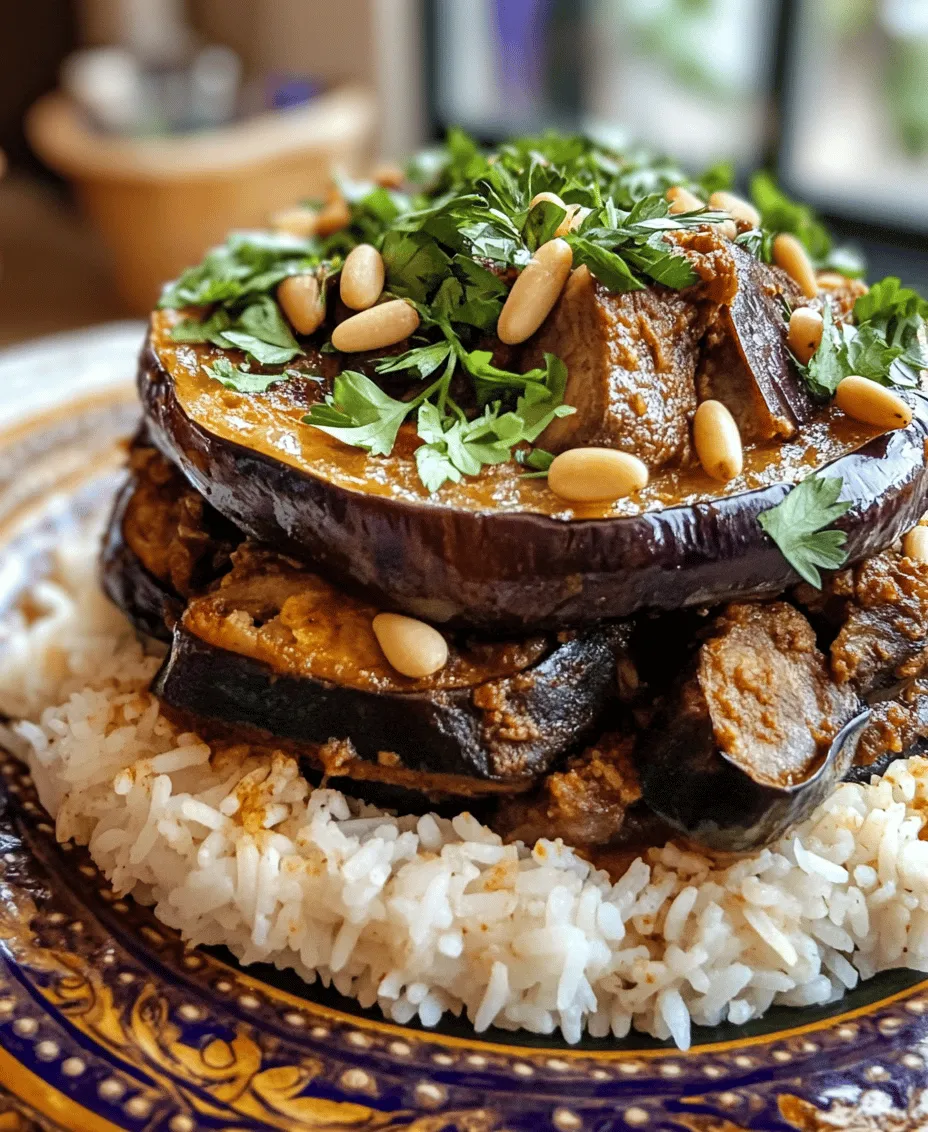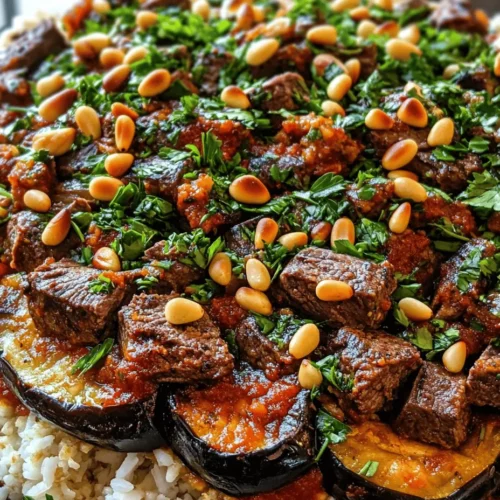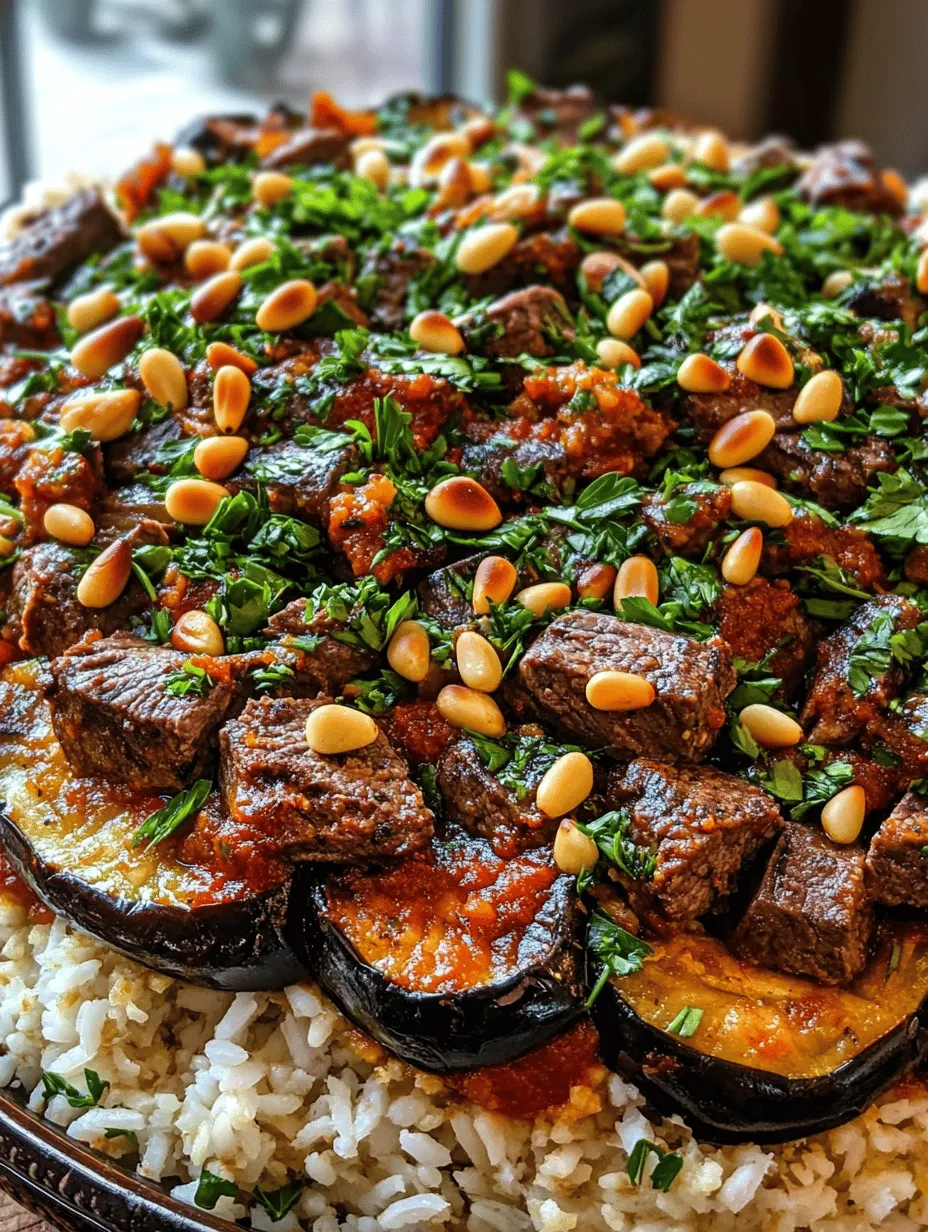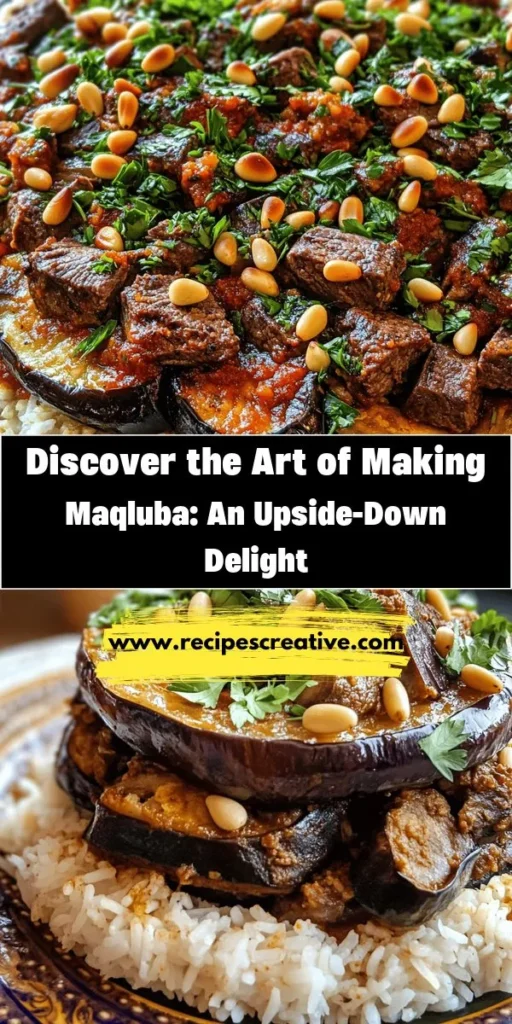Introduction
Maqluba, a traditional dish that finds its roots in the heart of Middle Eastern cuisine, is more than just a meal; it is a culinary experience steeped in history and communal spirit. The name “Maqluba” translates to “upside down,” aptly describing the unique way this dish is served. While each family may have its own cherished recipe, the essence remains the same: a hearty layering of rice, meat, and vegetables, which reveals a stunning presentation when flipped onto a serving plate.
This beloved dish is often enjoyed during family gatherings and special occasions, bringing loved ones together around a shared meal. The communal aspect of Maqluba is significant, as it symbolizes hospitality and generosity, inviting everyone to partake in its deliciousness. The dish is not only visually stunning but also packed with flavor, thanks to the variety of ingredients that meld together during cooking.
In this article, we will dive into the rich cultural history of Maqluba, explore its variations across different regions, and take a closer look at the ingredients that make this dish so appealing. We will also provide a detailed guide on the preparation steps, ensuring you can recreate this delightful upside-down dish in your own kitchen.
Understanding Maqluba: A Cultural Perspective
Maqluba has a storied history that dates back centuries, with its origins deeply rooted in the Levant region, including countries like Palestine, Jordan, and Lebanon. It is believed that the dish was created as a way to utilize leftover ingredients, transforming them into a hearty meal that could feed a large family. Over time, Maqluba evolved, gaining popularity not just in households but also in restaurants and celebrations.
Each country boasts its own variation of Maqluba, influenced by local ingredients and culinary traditions. In Palestine, for example, lamb is often the meat of choice, while in Jordan, chicken may take center stage. Vegetables such as eggplant, cauliflower, and potatoes are commonly used, but many families add their own twist by incorporating seasonal produce or personal favorites. This adaptability makes Maqluba a versatile dish that can cater to different tastes and dietary preferences.
The symbolism of Maqluba extends beyond its delicious flavor; it represents unity and togetherness. Traditionally, it is served from a single large pot, encouraging diners to gather around the table, share stories, and enjoy each other’s company. The act of flipping the pot upside down to reveal the beautifully layered dish adds an element of excitement, making it a focal point of any meal.
Ingredients Breakdown
To create an authentic Maqluba, the choice of ingredients is paramount. At the heart of the dish are three key components: rice, meat, and vegetables. Each ingredient plays a crucial role in the overall flavor and texture of the dish.
Key Ingredients
1. Rice: Long-grain rice, such as basmati or jasmine, is the preferred choice for Maqluba due to its fragrant aroma and fluffy texture when cooked. It absorbs the flavors of the meat and spices, resulting in a delightful base for the dish.
2. Meat: The type of meat used can vary greatly, but lamb and chicken are the most common choices. Lamb offers a rich, savory flavor, while chicken provides a lighter option. The meat is often seasoned and browned before layering, enhancing the overall taste of the dish.
3. Vegetables: Eggplant is a standout ingredient, providing a creamy texture that complements the rice and meat. Other vegetables like cauliflower, carrots, and potatoes can also be included, adding color and nutrition to the dish.
4. Spices: A blend of spices, including cumin, coriander, and allspice, elevates the dish, infusing it with warmth and depth. These spices not only enhance the flavor but also contribute to the aromatic experience of cooking Maqluba.
Nutritional Benefits
Maqluba is not only a feast for the senses but also a balanced meal. The combination of protein from the meat, carbohydrates from the rice, and vitamins from the vegetables ensures that it can provide essential nutrients in one dish. Eggplants, for example, are rich in fiber and antioxidants, while the spices used are known for their anti-inflammatory properties.
Using quality ingredients is essential for achieving the authentic flavors of Maqluba. Fresh vegetables and high-quality meat not only enhance the taste but also ensure that the dish is nutritious and satisfying. When selecting your ingredients, consider visiting local farmers’ markets or specialty stores to find the best produce and meats available.
Preparation Steps: A Detailed Guide
Now that we have explored the cultural significance and ingredients of Maqluba, it’s time to delve into the preparation steps. Making Maqluba may seem daunting at first, but with a clear guide, you’ll find that it is an enjoyable cooking experience that culminates in a stunning dish.
Step-by-Step Preparation
1. Gather Your Ingredients: Before you begin cooking, ensure that you have all your ingredients prepared and measured. This will make the cooking process smoother and more enjoyable.
2. Prepare the Eggplant: One of the most crucial steps in making Maqluba is preparing the eggplant. Begin by slicing the eggplant into thick rounds. To remove excess moisture and bitterness, sprinkle salt generously over the slices and let them sit for about 30 minutes. This process is known as “sweating” the eggplant and will help achieve a firmer texture during cooking.
3. Rinse and Pat Dry: After 30 minutes, rinse the salted eggplant under cold water to remove the excess salt, then pat them dry with a clean kitchen towel. This step is important to ensure that the eggplant doesn’t become too salty and retains its natural flavor.
4. Fry the Eggplant: In a large skillet or frying pan, heat a generous amount of oil over medium-high heat. Once the oil is hot, carefully add the eggplant slices in batches, ensuring not to overcrowd the pan. Fry the eggplant until golden brown on both sides, about 3-4 minutes per side. This technique will give the eggplant a delightful crispy exterior while keeping the interior tender. Once fried, remove the eggplant from the pan and place it on a paper towel to absorb excess oil.
5. Brown the Meat: In the same pan, add more oil if needed and sauté onions until they become translucent. Then, add your choice of meat (chicken or lamb) to the pan. Season with salt, pepper, and your choice of spices. Brown the meat on all sides, ensuring it develops a nice crust, which will enhance the overall flavor of the Maqluba.
By following these initial steps, you will create a solid foundation for your Maqluba. The next stages will involve layering the ingredients and cooking them together to create the final dish. Each step builds upon the previous one, culminating in a beautiful and delicious upside-down dish that is sure to impress your family and friends.

Cooking the Beef
To create a truly delicious Maqluba, the first step is to cook the beef to perfection. Start by selecting good quality beef, preferably chuck or brisket, as these cuts will provide the right balance of tenderness and flavor when cooked slowly. Cut the beef into bite-sized pieces, ensuring they are uniform to allow for even cooking.
Browning the Beef
Begin by heating a large, heavy-bottomed pot or Dutch oven over medium-high heat. Add a few tablespoons of vegetable oil, allowing it to warm up before adding the beef. It’s crucial not to overcrowd the pot, as this can lead to steaming rather than browning. If necessary, work in batches to achieve that coveted golden crust on each piece.
Once the beef is browned on all sides, remove it from the pot and set it aside. In the same pot, add finely chopped onions and sauté them until they become translucent and fragrant. This step is essential, as onions contribute sweetness that balances the richness of the beef.
Next, add minced garlic, cooking for another minute until aromatic. The combination of onions and garlic forms the flavor base for your Maqluba, enhancing the overall taste profile.
Building Flavor with Spices
When the onions and garlic are ready, return the browned beef to the pot. It’s time to spice things up! Add a mix of spices that are traditional to Maqluba, including cumin, allspice, and black pepper. Cumin brings a warm, earthy flavor, while allspice adds a hint of sweetness and depth. Don’t forget to season generously with salt to enhance the flavors further. Allow the spices to toast slightly with the meat and onions before adding the liquid to create a rich and aromatic broth.
Layering and Cooking
A hallmark of Maqluba is its unique layering process, which is vital for both flavor infusion and presentation. Begin by layering the ingredients in the pot: start with the cooked beef mixture, followed by sliced vegetables such as eggplant, cauliflower, and carrots.
Importance of Layering
The order in which you layer the ingredients significantly impacts the final dish. The denser ingredients, such as beef, should go on the bottom, while lighter vegetables can be placed on top. This ensures even cooking and allows the flavors to meld beautifully as they simmer together.
Once the layering is complete, add a layer of rinsed rice on top of the vegetables, ensuring it covers the entire surface. This step is crucial, as the rice will absorb the flavors from the beef and vegetables while cooking.
Guidelines for Adding Liquid and Simmering
To achieve the ideal rice texture, pour in the right amount of liquid—usually a mix of water and beef stock. The liquid should be about one inch above the rice layer. Cover the pot tightly with a lid to trap the steam, and bring the mixture to a gentle boil. Once boiling, reduce the heat to low and let it simmer for approximately 30-40 minutes. It’s essential to avoid lifting the lid during this time, as it allows steam to escape and can affect the cooking process.
After the cooking time is up, turn off the heat and let the Maqluba rest for about 10-15 minutes. This resting period allows the rice to absorb any remaining moisture and makes flipping the dish easier.
The Art of Serving Maqluba
Flipping the Maqluba is one of the most exciting parts of serving this dish. To ensure a smooth release, place a large serving platter upside down over the pot, then carefully flip it over in one swift motion. Gently lift the pot off, and behold the stunning upside-down presentation of your Maqluba.
Presentation Tips
To enhance the visual appeal, consider garnishing the dish with toasted nuts such as almonds or pine nuts, and fresh herbs like parsley or cilantro. These additions not only add a beautiful contrast but also a delightful crunch and freshness to each bite.
Suggested Accompaniments
Maqluba is a complete meal on its own, but it pairs wonderfully with various side dishes. A simple cucumber and tomato salad drizzled with olive oil and lemon juice adds a refreshing contrast. For something heartier, serve it with a side of yogurt or tzatziki sauce, which complements the spices beautifully. When it comes to drinks, consider a chilled mint tea or a refreshing lemonade to balance the richness of the dish.
Variations and Customizations
One of the beauties of Maqluba is its versatility, allowing for numerous variations and customizations to cater to different dietary preferences.
Exploring Vegetarian and Vegan Adaptations
For those seeking a vegetarian or vegan option, simply replace the beef with hearty vegetables such as mushrooms, zucchini, or chickpeas. This substitution not only maintains the dish’s integrity but also provides a deliciously satisfying meal. Use vegetable broth in place of beef stock to enhance the flavor without sacrificing the essence of the dish.
Substituting Different Proteins
If you prefer other protein sources, chicken is a popular alternative. Use bone-in, skin-on chicken thighs for added flavor, and follow the same cooking process as with beef. Lamb is another traditional choice that adds a rich, gamey flavor, especially if you’re looking to create an authentic Middle Eastern experience.
Experimenting with Spices and Additional Vegetables
Feel free to experiment with spices and additional vegetables. Adding saffron or turmeric can lend a beautiful golden hue to the rice, while vegetables like bell peppers or potatoes can enhance the dish’s texture and flavor. The key is to balance the flavors while staying true to the spirit of Maqluba.
Conclusion
Maqluba is more than just a meal; it’s a culinary tradition steeped in history and culture. This delightful upside-down dish represents the beauty of communal dining, bringing family and friends together around the table. Its layered flavors and stunning presentation make it a centerpiece worthy of any gathering.
As you embark on your journey to create your Maqluba, remember that the true joy of cooking lies not just in the final product but in the experience of preparing and sharing food with loved ones. We encourage you to try making Maqluba at home, embrace the process, and share your success with others. The joy of cooking and the connections we forge through food are what truly enrich our lives.



